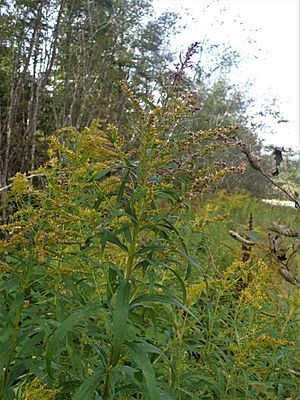Solidago brendiae facts for kids
Quick facts for kids Solidago brendiae |
|
|---|---|
 |
|
| Scientific classification | |
| Genus: |
Solidago
|
| Species: |
brendiae
|
Solidago brendiae is a type of goldenrod flower. It belongs to the sunflower family, which also includes sunflowers and daisies. This plant grows naturally in the northeastern parts of North America.
Contents
What is Brenda's Goldenrod?
Solidago brendiae is a perennial herb. This means it lives for more than two years. It can grow quite tall, reaching up to 160 centimeters (about 64 inches). The plant spreads using special underground stems called rhizomes. These rhizomes help new plants grow nearby.
What Does It Look Like?
The leaves of Brenda's goldenrod are long and narrow. They can be up to 15 centimeters (about 6 inches) long. These leaves are attached directly to the main stem. They do not grow in a cluster around the base of the plant.
When it blooms, one plant can have many small yellow flowers. Sometimes, a single plant can have as many as 500 tiny flower heads. These flowers grow in a large group at the very top of the plant.
Where Does It Grow?
Brenda's goldenrod is found in several places in Canada. You can see it in Labrador, Newfoundland, and all three Maritime Provinces. It also grows in Québec.
In the United States, it is found in northeastern Vermont, especially near Granby. Scientists think there might be a few more groups of these plants in Maine and Ontario.
How Did It Get Its Name?
This plant was named after Brenda Semple. She is the wife and research partner of John C. Semple. He was the scientist who first described this species in a scientific paper. It's a way to honor her contributions to the research.

